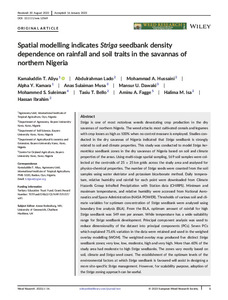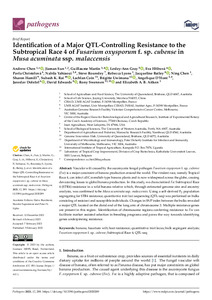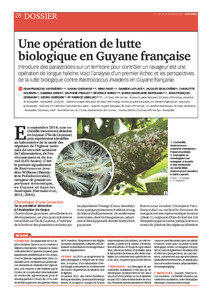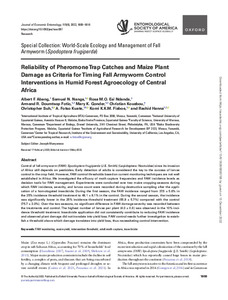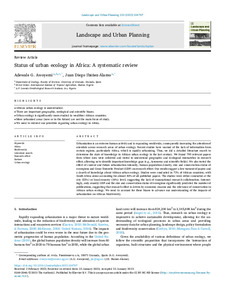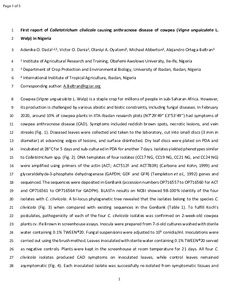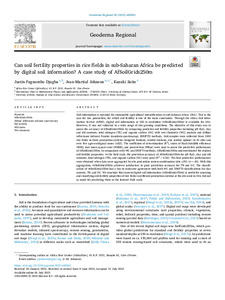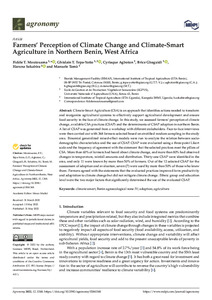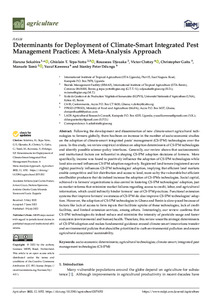Welcome to the International Institute of Tropical Agriculture Research Repository
Journal and Journal Articles: Recent submissions
Now showing items 441-460 of 5285
-
Spatial modelling indicates Striga seedbank density dependence on rainfall and soil traits in the savannas of northern Nigeria
(2023-02-13)Striga is one of most notorious weeds devastating crop production in the dry savannas of northern Nigeria. The weed attacks most cultivated cereals and legumes with crop losses as high as 100% when no control measure is employed. Studies conducted in the dry savannas of Nigeria indicated that Striga seedbank is strongly related to soil and climate properties. This study was conducted to model Striga hermonthica seedbank zones in the dry savannas of Nigeria based on soil and climate properties of ... -
Identification of a major QTL-controlling resistance to the subtropical race 4 of Fusarium oxysporum f. sp. cubense in Musa acuminata ssp. malaccensis
(2023-02-09)Vascular wilt caused by the ascomycete fungal pathogen Fusarium oxysporum f. sp. cubense (Foc) is a major constraint of banana production around the world. The virulent race, namely Tropical Race 4, can infect all Cavendish-type banana plants and is now widespread across the globe, causing devastating losses to global banana production. In this study, we characterized Foc Subtropical Race 4 (STR4) resistance in a wild banana relative which, through estimated genome size and ancestry analysis, was ... -
Variability and genetic merits of white Guinea yam landraces in Nigeria
(2023-02-06)Introduction: Landraces represent a significant gene pool of African cultivated white Guinea yam diversity. They could, therefore, serve as a potential donor of important traits such as resilience to stresses as well as food quality attributes that may be useful in modern yam breeding. This study assessed the pattern of genetic variability, quantitative trait loci (QTLs), alleles, and genetic merits of landraces, which could be exploited in breeding for more sustainable yam production in Africa. ... -
Une operation de lutte biologique en Guyane
(2022-09)Contexte - En septembre 2014, l’espèce invasive, Rastrococcus invadens Williams (Hemiptera : Pseudococcidae) a été détectée à Cayenne (Guyane), puis rapidement identifiée par le LSV-Anses. C’est le premier signalement de la cochenille sur le continent sud-américain. À la demande du ministère de l’Agriculture, une mission a été réalisée par le Centre de coopération internationale en recherche agronomique pour le développement (Cirad) fin 2016 afin de définir la gamme des plantes-hôtes de R. invadens, ... -
Mapping quantitative trait loci and predicting candidate genes for Striga resistance in maize using resistance donor line derived from Zea diploperennis
(2023-01-12)The parasitic weed, Striga is a major biological constraint to cereal production in sub-Saharan Africa (SSA) and threatens food and nutrition security. Two hundred and twenty-three (223) F2:3 mapping population involving individuals derived from TZdEI 352 x TZEI 916 were phenotyped for four Striga-adaptive traits and genotyped using the Diversity Arrays Technology (DArT) to determine the genomic regions responsible for Striga resistance in maize. After removing distorted SNP markers, a genetic ... -
Assessment of biochemical, cooking, sensory and textural properties of the boiled food product of white yam (D. rotundata) genotypes grown at different locations
(2022-12)Specific biochemical properties and textural attributes determine the final quality and acceptability of yam food products. This study assessed the flour and cooking qualities (boiled yam) of sixteen elite white yam genotypes (D. rotundata) grown in three locations. Fresh yam samples were cut into regular-shaped pieces and boiled using the standard procedure. Sub-samples were oven-dried at 65 °C for 72 h and milled to flour. The biochemical profiling for the yam flour showed, on average, 61.35 ± ... -
Quantifying potential yield and yield gaps of soybean using CROPGRO-soybean model in the humid tropics of southwestern Ethiopia
(2022-10-24)In the past, much of the emphasis on soybean research in Ethiopia has been on the development and testing of new varieties and classical agronomic trials with limited use of crop models that help in estimating the potential yield and yield gaps, and identifying the most important barriers of achieving optimal yield. CROPGRO-soybean model is an important tool for estimating the potential yield and yield gaps of soybean under various management and environmental conditions. The objectives of this ... -
Species richness, density, activity, and composition of ground-dwelling ants in the humid forest zone of southern Cameroon: role of vegetation cover and abiotic factors
(2022-12)The destruction of natural habitats is among the major factors responsible for the decrease in species diversity and distribution. This study focused on the effect of vegetation and its interaction with the season on ant species richness, density, activity, and composition in the three dominant habitats – forest, fallow, and mixed crop field – prevailing in southern Cameroon. Ants were sampled using two sampling techniques –pitfall trap and quadrat – in fallows, forest, and mixed crop fields from ... -
Reliability of pheromone trap catches and maize plant damage as criteria for timing fall armyworm control interventions in humid forest agroecology of central Africa
(2022)Control of fall armyworm (FAW) Spodoptera frugiperda (J.E. Smith) (Lepidoptera: Noctuidae) since its invasion of Africa still depends on pesticides. Early detection of adults is considered the key to the success of larvae control in the crop field. However, FAW control thresholds based on current monitoring techniques are not well established in Africa. We investigated the efficacy of moth capture frequencies and FAW incidence levels as decision tools for FAW management. Experiments were conducted ... -
Status of urban ecology in Africa: a systematic review
(2023-05)Urbanization is an extreme human activity and is expanding worldwide, consequently increasing the attention of scientists across research areas of urban ecology. Recent studies have warned of the lack of information from certain regions, particularly Africa, which is rapidly urbanizing. Thus, we did a detailed literature search to determine the state of knowledge in African urban ecology in the last century. We found 795 relevant papers from where data were collected and tested to understand ... -
Smallholder farmers' perception and challenges toward the use of crop residues and agro-industrial byproducts in livestock feeding systems in eastern DR Congo
(2022-07)The extent of crop residues and agricultural byproducts utilization for their integration in feeding systems in Eastern DR Congo was assessed in South-Kivu (Walungu territoire) and two territoires in the Tanganyika province (Kalemie and Moba territoires). Data were collected through 21 focus group discussions in which 273 farmers participated including respectively 116 (42%) from South Kivu and 157 (58%) from Tanganyika province. A logistic regression model was used to determine factors influencing ... -
Micro-climatic variations across Malawi have a greater influence on maize susceptibility to aflatoxins than to fumonisins
(2022-11-29)This study reports levels of aflatoxin and fumonisin in maize samples (n = 1294) from all agroecological zones (AEZs) in Malawi. Most maize samples (> 75%) were contaminated with aflatoxins and 45% with fumonisins, which co-occurred in 38% of the samples. Total aflatoxins varied across the AEZs, according to mean annual temperature (P < 0.05) of the AEZs. Samples from the lower Shire AEZ (median = 20.8 µg/kg) had higher levels of aflatoxins (P < 0.05) than those from the other AEZs (median = 3.0 ... -
First report of Colletotrichum cliviicola causing anthracnose disease of cowpea (Vigna unguiculata L. Walp) in Nigeria
(2022-12-21)Cowpea (Vigna unguiculata L. Walp) is a staple crop for millions of people in sub-Saharan Africa. However, its production is challenged by various abiotic and biotic constraints, including fungal diseases. In February 2020, around 10% of cowpea plants in IITA-Ibadan research plots (N7°29'49'' E3°53'49'') had symptoms of cowpea anthracnose disease (CAD). Symptoms included reddish brown spots, necrotic lesions, and vein streaks (Fig. 1). Diseased leaves were collected and taken to the laboratory, ... -
Impact of frequency of application on the long-term efficacy of the biocontrol product Aflasafe in reducing aflatoxin contamination in maize
(2022)Aflatoxins, produced by several Aspergillus section Flavi species in various crops, are a significant public health risk and a barrier to trade and development. In sub-Saharan Africa, maize and groundnut are particularly vulnerable to aflatoxin contamination. Aflasafe, a registered aflatoxin biocontrol product, utilizes atoxigenic A. flavus genotypes native to Nigeria to displace aflatoxin producers and mitigate aflatoxin contamination. Aflasafe was evaluated in farmers’ fields for 3 years, under ... -
Spatial and temporal population dynamics of Aspergillus flavus in commercial pistachio orchards in Arizona
(2022-06-09)Aspergillus flavus infects a wide range of crops, including pistachio, and subsequent aflatoxin contamination results in significant economic losses. Application of biocontrol products based on nonaflatoxigenic (atoxigenic) strains of A. flavus is one of the most effective tactics for controlling aflatoxins in crops. Both risk of aflatoxin contamination and effectiveness of biocontrol are influenced by the extent to which A. flavus spores move into pistachio tree canopies during periods of nut ... -
Can soil fertility properties in rice fields in sub-Saharan Africa be predicted by digital soil information? A case study of AfSoilGrids250m
(2022)Soil information is essential for sustainable agricultural intensification in sub-Saharan Africa (SSA). This is the case for rice production, for which soil fertility is one of the main constraints. Through the Africa Soil Information Service (AfSIS), digital soil information at 250 m resolution (AfSoilGrids250m) is available for SSA. However, it was not validated in a wide range of rice-growing conditions. The objective of this study was to assess the accuracy of AfSoilGrids250m by comparing ... -
Assessing the performance and participation among young male and female entrepreneurs in agribusiness: a case study of the rice and maize subsectors in Cameroon
(2021-03-02)The role played by youth in agriculture cannot be overemphasized, while agribusinesses are important generators of employment and income worldwide. Improving the sustainability of food value chains can benefit millions of rural poor people living in developing countries, especially young women. Despite policies and programs aimed at encouraging agricultural entrepreneurs, they are still facing challenges such as high-cost agrochemicals, limited access to credit, price volatility, etc. which seriously ... -
Farmers' perception of climate change and climate-smart agriculture in northern Benin, west Africa
(2022-05-31)Climate-Smart Agriculture (CSA) is an approach that identifies actions needed to transform and reorganize agricultural systems to effectively support agricultural development and ensure food security in the face of climate change. In this study, we assessed farmers’ perception of climate change, available CSA practices (CSAP) and the determinants of CSAP adoption in northern Benin. A list of CSAP was generated from a workshop with different stakeholders. Face-to-face interviews were then carried ... -
Determinants for deployment of climate-smart integrated pest management practices: a meta-analysis approach
(2022-07-19)Following the development and dissemination of new climate-smart agricultural technologies to farmers globally, there has been an increase in the number of socio-economic studies on the adoption of climate-smart integrated pests’ management (CS-IPM) technologies over the years. In this study, we review empirical evidence on adoption determinants of CS-IPM technologies and identify possible science-policy interfaces. Generally, our review shows that socioeconomic and institutional factors are ... -
Estimating genetic gains for tolerance to stress combinations in tropical maize hybrids
(2022-12-08)Maize is a strategic food crop in sub-Saharan Africa. However, most maize growing tropical savannas particularly in West and Central African experience the occurrence of frequent droughts and Striga infestation, resulting in 30–100% yield losses. This production zones need maize cultivars that combine tolerance to the two stresses. IITA in collaboration with national partners has thus employed a sequential selection scheme to incorporate both drought tolerance and Striga resistance in topical maize ...

